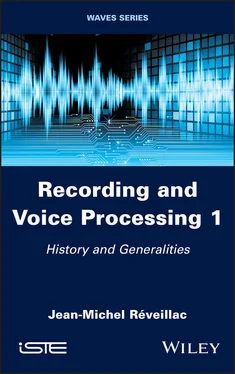4 Chapter 3Figure 3.1. Sir Charles WheatstoneFigure 3.2. Johann Philipp ReisFigure 3.3. Reis’s telephone with its transmitter (microphone), left, and receiv...Figure 3.4. The water microphone of A. G. Bell and E. Gray Over the months, the ...Figure 3.5. One of the sketches of the telephone patent filed by A. G. BellFigure 3.6. Principle of the carbon microphone. For a color version of this figu...Figure 3.7. Schematic diagram of a dynamic moving coil microphone. For a color v...Figure 3.8. Charcoal microphone pad. The diaphragm can be seen on the right thro...Figure 3.9. A triodeFigure 3.10. Schematic diagram of a condenser microphone. For a color version of...Figure 3.11. The first mass-produced condenser microphone, the Neumann CVM3 (192...Figure 3.12. Principle of the piezoelectric microphone. For a color version of t...Figure 3.13. Two vintage shotgun microphones: top: Sony ECM672 (1985), bottom: E...Figure 3.14. Three germanium transistors. Their dimensions speak for themselves,...Figure 3.15. The double membrane capsule, named M7, built by G. Neumann. For a c...Figure 3.16. The electret microphone and its principle. For a color version of t...Figure 3.17. The MEMS microphone and its principle. For a color version of this ...Figure 3.18. Evolution of the microphone over time. For a color version of this ...Figure 3.19. Pressure transducer. For a color version of this figure, see www.is...Figure 3.20. Sum of incident and reflected waves. For a color version of this fi...Figure 3.21. A phase shift of 180° cancels the signal. For a color version of th...Figure 3.22. Acoustic operation of a pressure gradient microphone. For a color v...Figure 3.23. The frequency response curve of a Shure SM58 MicrophoneFigure 3.24. Directivity diagrams of a Shure SM58SE microphoneFigure 3.25. The directivity diagram for a perfect omnidirectional microphoneFigure 3.26. The directivity diagram for the Shure SM80-LC omnidirectional micro...Figure 3.27. The directivity diagram for a perfect hemispherical microphoneFigure 3.28. The directivity diagram for the AKG C547BL hemispherical microphone...Figure 3.29. The directivity diagram for a perfect bidirectional microphoneFigure 3.30. The directivity diagram for the Audio-Technica AT4080 bidirectional...Figure 3.31. The directivity diagram for a perfect cardioid microphoneFigure 3.32. The directivity diagram for the Shure D5C cardioid microphone on th...Figure 3.33. The directivity diagram for a perfect supercardioid microphoneFigure 3.34. Comparison of supercardioid directivity, green and dotted, and card...Figure 3.35. The directivity diagram for the Rode NTG-2 supercardioid microphone...Figure 3.36. The directivity diagram for a perfect hypercardioid microphoneFigure 3.37. The directivity diagram for the Audio Technica AT4053b supercardioi...Figure 3.38. The directivity diagram for a perfect subcardioid microphoneFigure 3.39. The directivity diagram for the Audio Technica AT808G subcardioid m...Figure 3.40. The directivity diagram for a perfect shotgun microphoneFigure 3.41. Directivity diagram for the Rode NTG-1 shotgun microphones, left, a...Figure 3.42. Two power supplies, the Neumann M149A model specifically for the Ne...Figure 3.43. A transformer with its core and two windings. For a color version o...Figure 3.44. A typical microphone transformer (14 x 10 x 12 mm). For a color ver...Figure 3.45. A 1 ms audio signal sampled at 96 kHz. For a color version of this ...Figure 3.46. Microphone configuration according to the Blumlein system. For a co...Figure 3.47. Microphone configuration according to the MS system. For a color ve...
5 Chapter 4Figure 4.1. Direct sound and indirect or reflected sound. For a color version of...Figure 4.2. Foam bass traps for wall corners (Auralex)Figure 4.3. Absorbing panel type bass trap (t.akustic)Figure 4.4. Porous absorber – absorption curves (without absorber (green), absor...Figure 4.5. Example of an attenuation curve for a Helmholtz absorber. For a colo...Figure 4.6. Perforated Helmholtz panel (Acoustissimo, left) and laminar resonato...Figure 4.7. Cylindrical Helmholtz absorbers (Vicoustic and Hofa). For a color ve...Figure 4.8. Diaphragm bass traps (GIK Acoustics). For a color version of this fi...Figure 4.9. Mechanical analogy for a diaphragm or flexural bass trap. For a colo...Figure 4.10. Two examples of active bass traps (PSI Audio – Bag End)Figure 4.11. A specular reflection, the angle of the incident wave is equal to t...Figure 4.12. Comb filtering between 20 and 20 kHz. For a color version of this f...Figure 4.13. Two Schroeder diffusers. For a color version of this figure, see ww...Figure 4.14. Quadratic diffuser, also called QRD diffuser (Auralex, t.akustic an...Figure 4.15. The flutter echo principle. For a color version of this figure, see...Figure 4.16. A poly-cylindrical diffuser (Acoustic Geometry and GIK Acoustics). ...Figure 4.17. Diffusers with original designs (Jocavi and Jaya). For a color vers...Figure 4.18. Examples of removable cabins (Clearsonic and t.akustic)Figure 4.19. A cabin with removable panels on a tripod (Power Studio)Figure 4.20. Premanufactured acoustic booths (Vicoustic and Keoda). For a color ...Figure 4.21. Three examples: a tripod (Neewer), microphone stand (Tonor) and tab...Figure 4.22. A sound barrier and a sound recording sessionFigure 4.23. A universal pop filterFigure 4.24. Pop filters of various shapes (t-Bone, Aston and Tuloka)Figure 4.25. A closed headphone, left, and an open headphone, right (Beyerdynami...Figure 4.26. Power loss (attenuation) curve according to amplifier output impeda...Figure 4.27. Graph for determining the power required for a headphone based on i...Figure 4.28. Different types of suspensions: spider, double-lyre, universal, buo...Figure 4.29. Examples of standsFigure 4.30. Examples of boom standsFigure 4.31. Examples of articulating armsFigure 4.32. Examples of different gooseneck microphonesFigure 4.33. Thread adapter for microphone support and suspensionFigure 4.34. Ball joint adapter (Gravity)Figure 4.35. Different types of foam cups (Shure, Sennheiser and Rode). For a co...Figure 4.36. Long-hair cap (Rode and Rycote)Figure 4.37. Cage and windjammer caps (Rycote)Figure 4.38. An anechoic chamber (CNRS, LMA Laboratory and Aix-Marseille Univers...
6 Appendix 1Figure A1.1. Sound level scalesFigure A1.2. Comparison of bel, decibel (dB SPL) and pascal (Pa). For a color ve...Figure A1.3. Psophometric diagram (weighted curve) dBA
7 Appendix 2Figure A2.1. Some models of coaxial jacks. 1) subminiature 2.5 mm mono male jack...Figure A2.2. The different contact points for the 6.35 mm jack connectorsFigure A2.3. A “Bantam” or TT patchbay cable in TRS versionFigure A2.4. Pinout of the 3-pin XLR connectorsFigure A2.5. Wiring diagram of a classic XLR cable. For a color version of this ...Figure A2.6. Wiring diagram of XLR jack adapters. For a color version of this fi...Figure A2.7. Wiring diagram for an insert cord. For a color version of this figu...Figure A2.8. Different types of USB connectorsFigure A2.9. Different USB connectorsFigure A2.10. Some Sub-D connectors and a female Sub-D/XLR breakout cable. For a...Figure A2.11. BNC male and chassis connectorsFigure A2.12. RCA male and female connectors and chassis. For a color version of...Figure A2.13. Toslink male and chassis connectorsFigure A2.14. A Toslink/Mini Toslink cable
8 Appendix 4Figure A4.1. A tube microphone, Neumann U47. The tube can be seen in the center,...Figure A4.2. Principle of a triode and a Telefunken VF14 1tube designed specific...Figure A4.3. Schematic of an FET transistor (M type on the left, P type on the r...Figure A4.4. A widely used JFET transistor, the 2N3819Figure A4.5. A Neumann U87 clone. The arrow indicates the famous JFET (2N3819) m...
9 Appendix 5Figure A5.1. Principle of the AB pairFigure A5.2. An AB pairFigure A5.3. Principle of the XY pairFigure A5.4. An XY pairFigure A5.5. The Rode NT4 XY stereo microphoneFigure A5.6. Principle of the ORTF pairFigure A5.7. An ORTF pairFigure A5.8. Principle of the MS pairFigure A5.9. An MS pairFigure A5.10. Principle of the Decca treeFigure A5.11. Decca tree installationFigure A5.12. Principle of the Blumlein methodFigure A5.13. A Blumlein installationFigure A5.14. Principle of the Faulkner ArrayFigure A5.15. Principle of the sound-absorbing disk methodFigure A5.16. A Jecklin Disk installationFigure A5.17. Principle of the artificial headFigure A5.18. Neumann KU100 artificial head
Читать дальше












